Satellite images show fuel oil spill from Russian tankers in the Black Sea
On December 15, two Russian tankers sank in the Kerch Strait near Crimea. Between 2,500 and 4,500 tons of fuel oil could have been released into the sea. It's a catastrophe for the environmental. In total, the fuel oil stains from Russian tankers that were found at sea from December 18 to January 5 could cover more than 1,000 km² of water surface, which is approximately the area of New York City.
It's not easy to identify fuel oil stains using satellite imagery, but we've figured out how the pollution has spread by sea in recent weeks. You can learn more below about the methodology.
Detecting a pollution spot is labor-intensive and requires significant computer resources, but it doesn't guarantee automatic spotting, even if it is clearly visible.
Methods for detecting oil pollution from radar images can be divided into three main groups:
Methods based on expert assessment; in essence, this is a visual analysis of the image by a person using a certain set of compliance criteria;
Interactive methods, which involve preliminary automated image processing and subsequent human analysis;
Automated methods, i.e., executable modules or software tools that automatically recognize oil slicks without human intervention.
Ukrainian scientific center of Ecology of Sea (UkrSCES) explains that the sea surface smoothing zones (slicks), which are displayed on radar images as more contrasting black areas against the background of the usual gray water surface, can be divided into three classes:
Slicks caused by marine phenomena (internal waves, vortex structures, upwelling, ice formation, etc. can be the reasons)
Slicks resulting from atmospheric processes (calm zones, wind shadows along the coast, rain cells, gravity waves, etc;)
Slicks formed by substances capable of changing the strength of surface tension are films of various organic compounds, including oil-containing products, films of surfactants, films of biological origin (biogenic films), and films of synthetic surfactants.
To correctly classify a slick, wind speed and direction, current speed and direction, ice conditions, bathymetric data, slick shape and size, oil infrastructure data, etc., must be considered.
Wind causes waves on the water and plays an important role in analyzing detected slicks. At low wind speeds (2-5 m/s), slicks form the thinnest films that are easily carried by the current. They usually exist in the form of long (tens and hundreds of kilometers), often curved or spiral stripes. It is somewhat difficult to recognize oil slicks in areas with large accumulations of biogenic films.
It is also important to analyze the slick in terms of its linear dimensions (length, width), area characteristics, shape, contrast, and type of contour (feather-like, clear, blurred).
Based on the above, it is true that not all black areas seen in Sentinel-1 images are fuel oil.
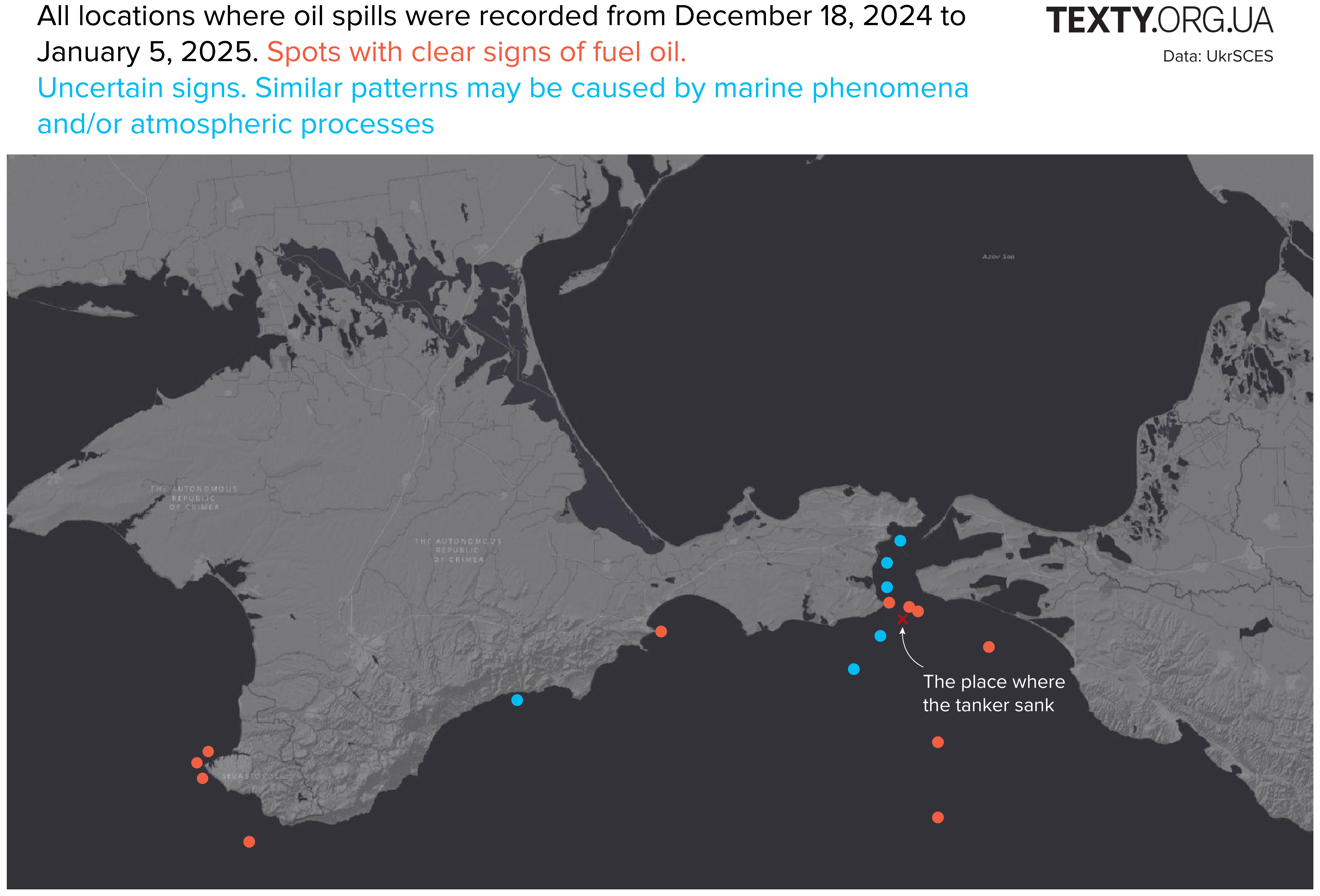
December 18
The satellite detected the first fuel oil spots on the third day after the accident. In the image from December 18, these are dark areas near the accident site. The stains on both images are about 10 km long.
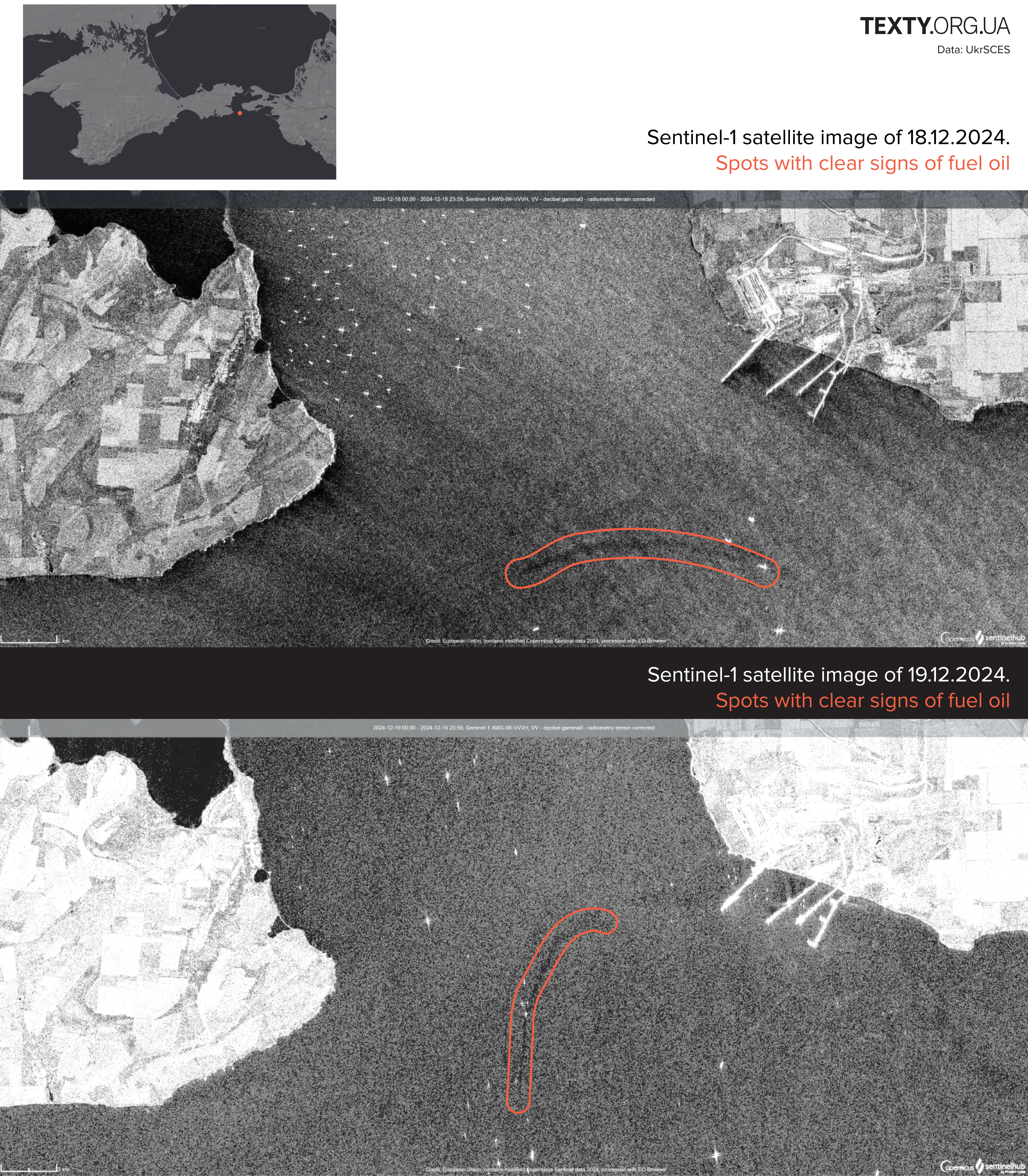
Analysis of the images shows the movement of fuel oil in the direction of the Azov Sea.
December 19
Another satellite image from December 19 shows a fuel oil slick about 35 km long off the coast of the Krasnodar Region of Russia.
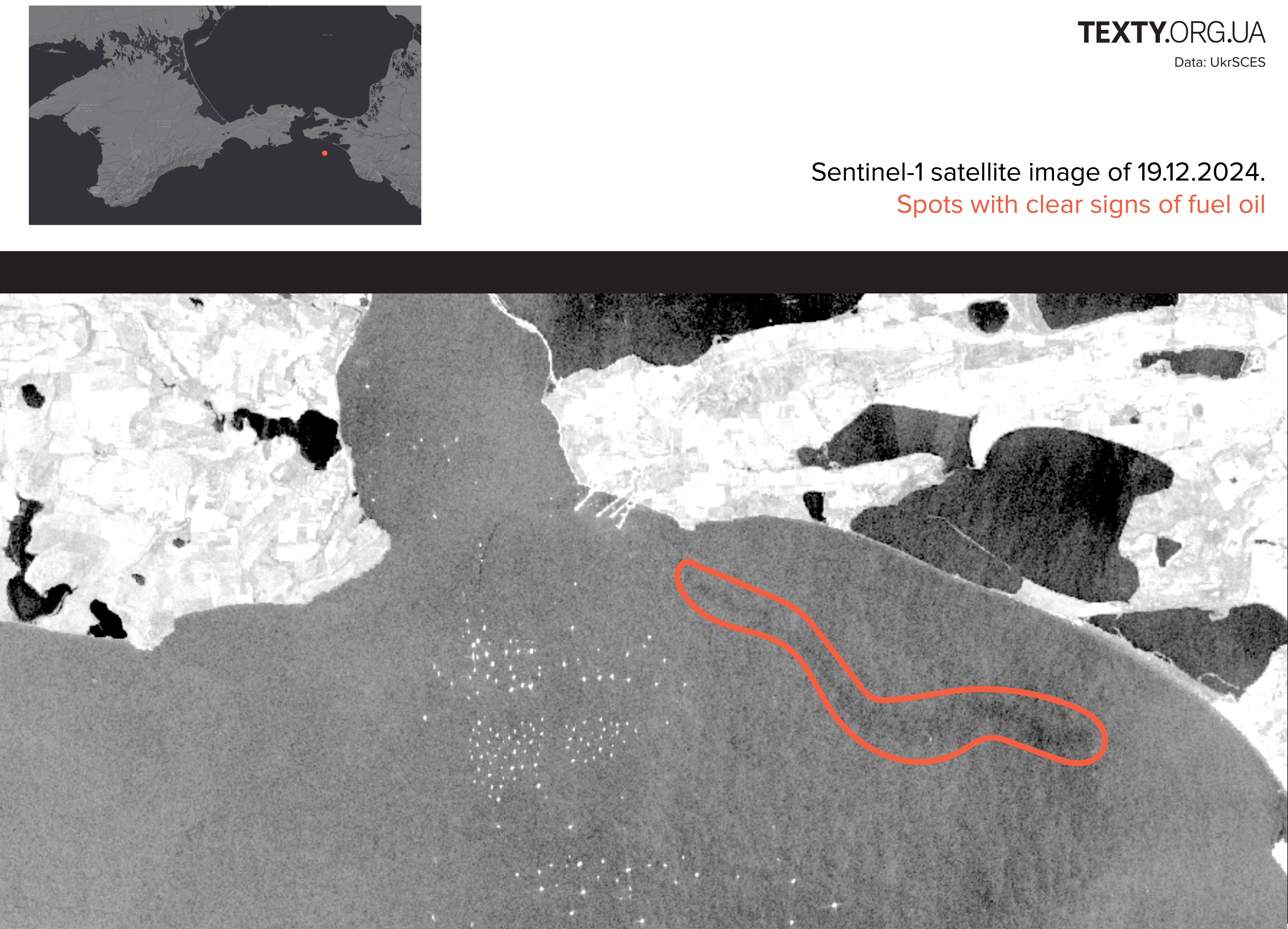
December 23
Black spots visually similar to fuel oil appear in the Kerch Strait off the eastern coast of Crimea. However, the Ukrainian scientific center of Ecology of Sea doubts that these spots are caused by oil products or only by them, as some atmospheric processes may appear similarly on satellite images.
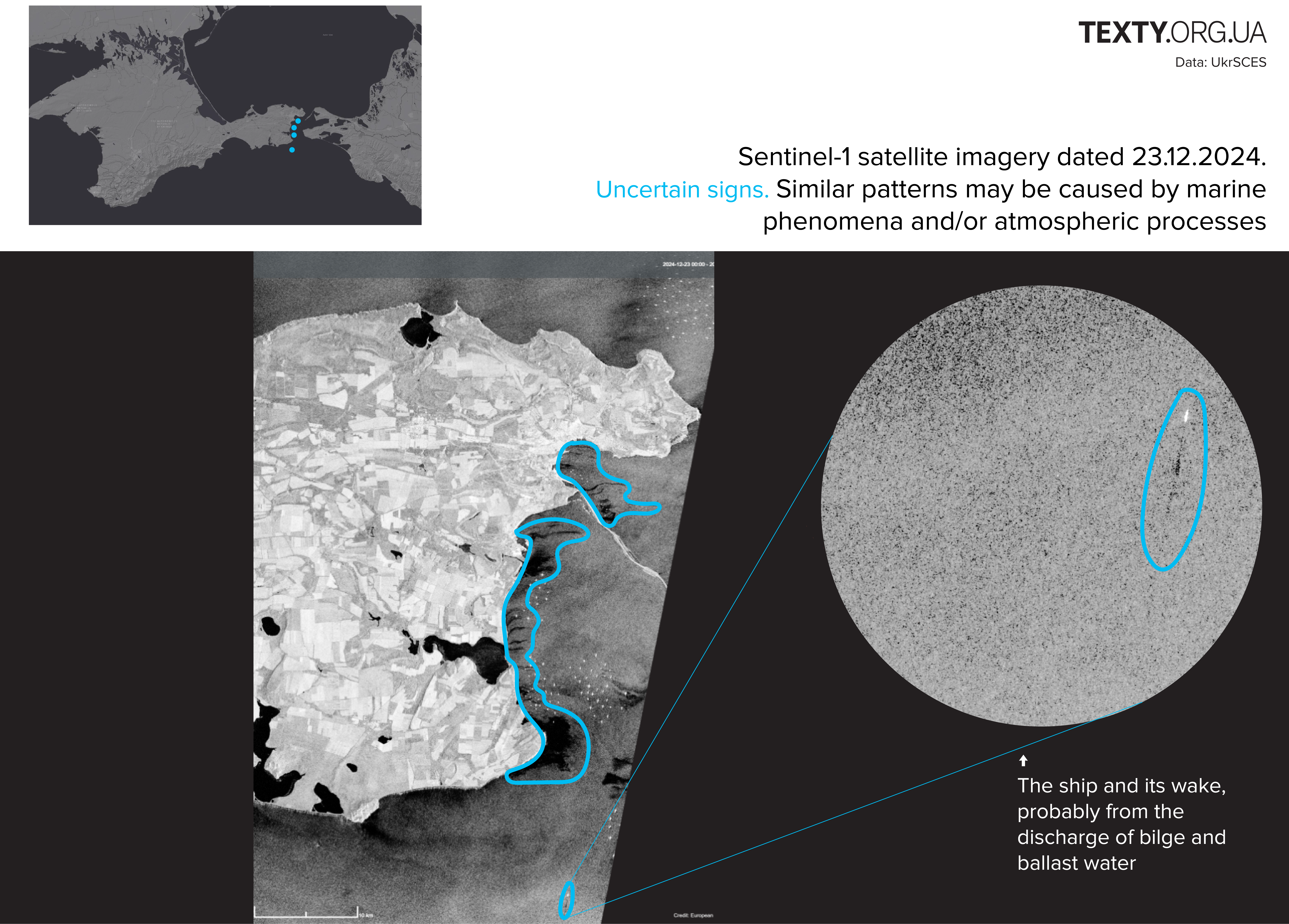
The detailed image above shows the ship (bright white dash) and the wake behind it (dark spot), which is likely the result of the discharge of bilge water (a mixture of water, oil residues, fuel waste, oils, and other substances that accumulate in the bilge compartments of ships). The length of the wake is 4 km. This is also pollution, but it's not related to the accident on December 15.
Support TEXTY.org.ua
TEXTY.ORG.UA is an independent media without intrusive ads and puff pieces. We need your support to continue our work.
December 29
On December 29, an image from December 29 shows oil spots characteristic of oil products off the southern coast of Crimea, 17 km from Cape Sarych. The total area of the detected spot is 160 km², the maximum length is about 25 km, and the width is 11 km. For comparison, this is approximately equal to the area of Miami, the USA (143 km²).
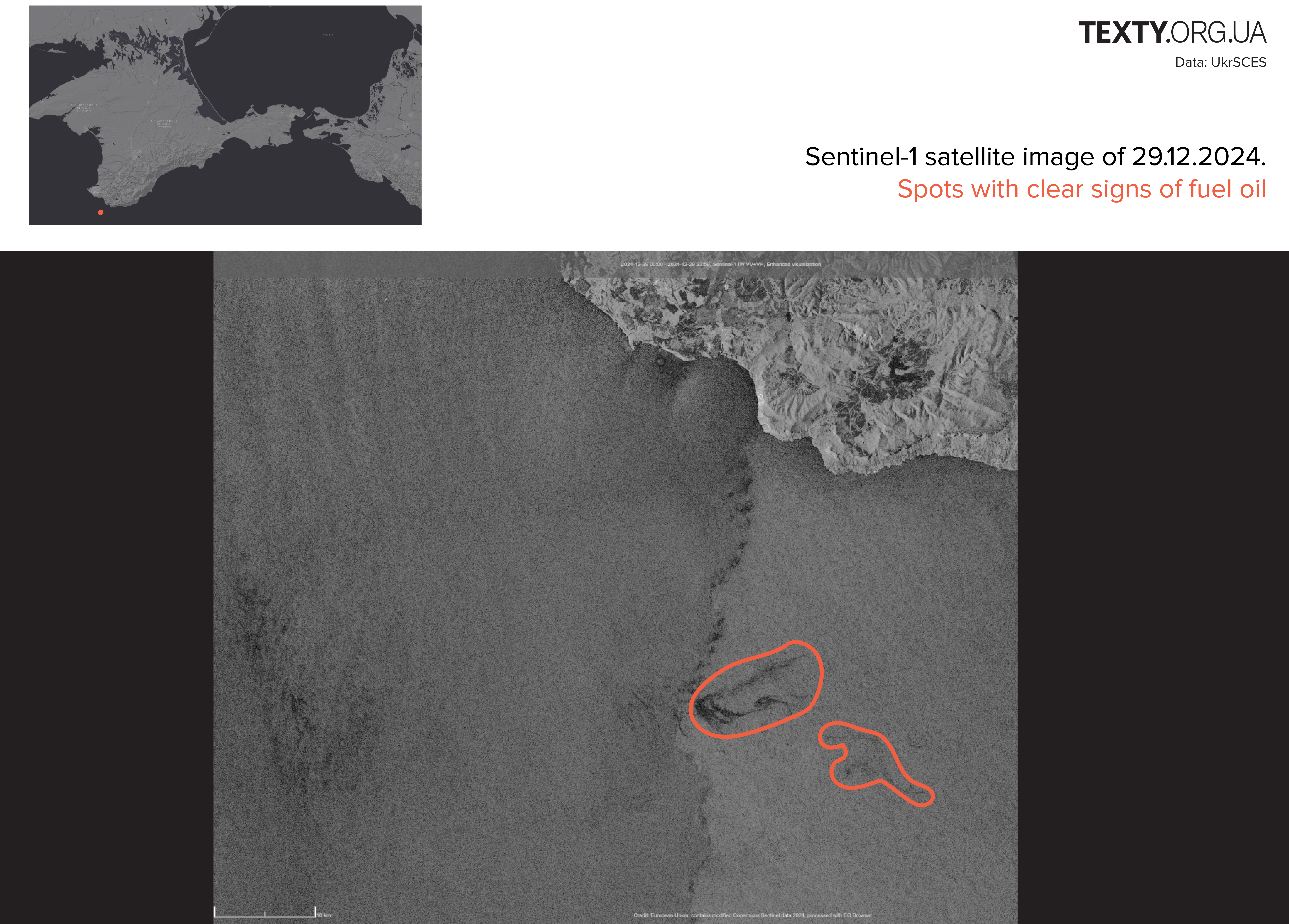
December 30
The image shows a spot of pollution about 30 km long south of the village of Volna in the Krasnodar Region of Russia. The area of the spot reaches 30 km².
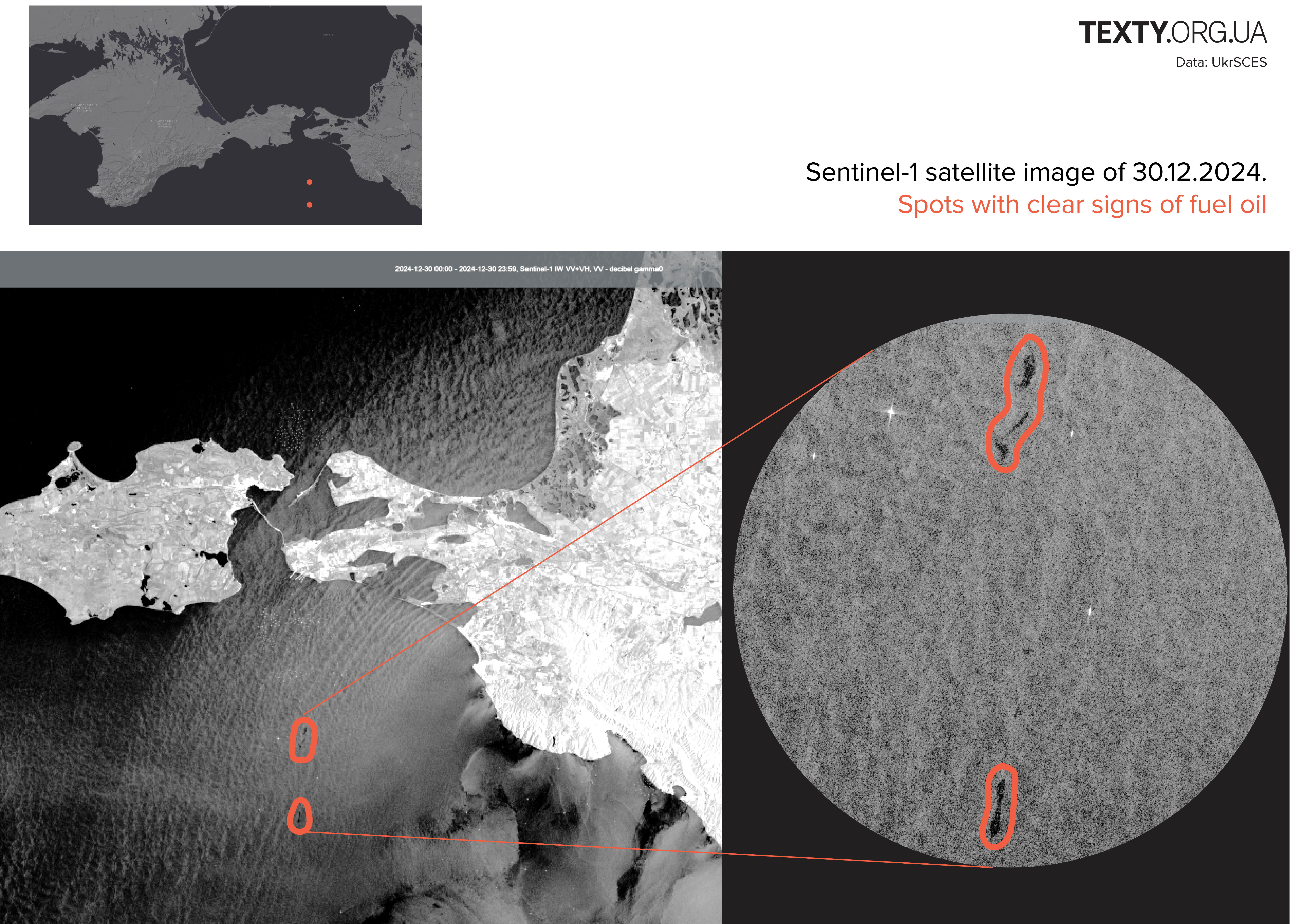
December 31
The satellite spotted two spots at the entrance to the Kerch Strait from the Black Sea: a larger one with an area of about 10 km² and a smaller one with an area of 3 km² at a distance of 28-30 km south of Cape Opuk.
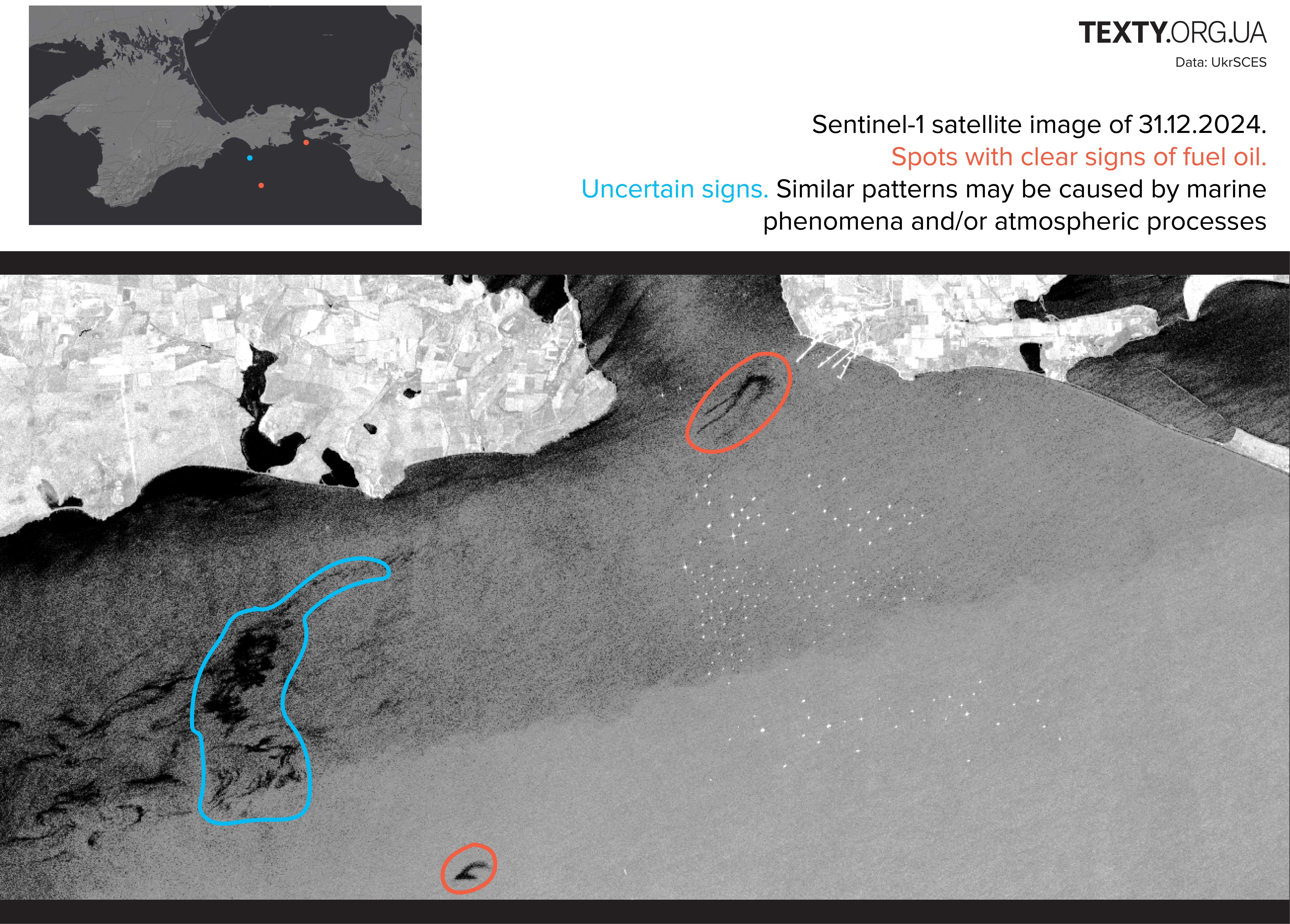
Why is it so difficult to identify the stains?
The patterns in the image from December 24 look very similar to oil slicks, but most likely they are not.
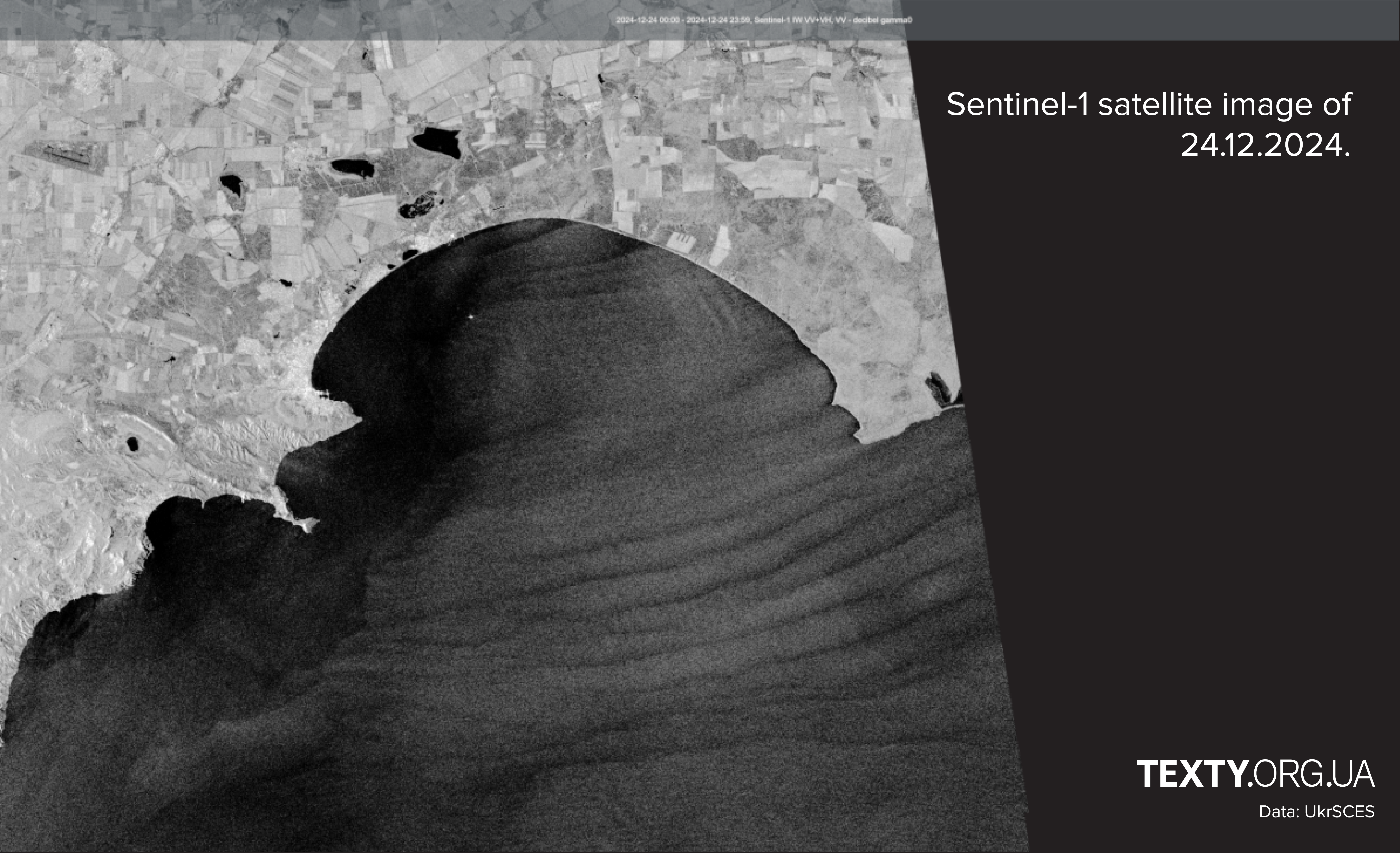
The dark streaks near the Gulf of Feodosia, stretching from east to west, are most likely caused by the wind, as the Ukrainian scientific center of Ecology of Sea explains. Strong winds lead to the spread of pollution, which is exactly what happened, as soon after, reports of fuel oil were found near Sevastopol, Feodosia, and other cities along the southeastern, southern, and western coasts of Crimea.
January 4
The image shows oil stains covering an area of about 2 km² near Feodosia and 0.25 km² near Cape Takil. There is less certainty about the pollution between Partenit and Sudak.
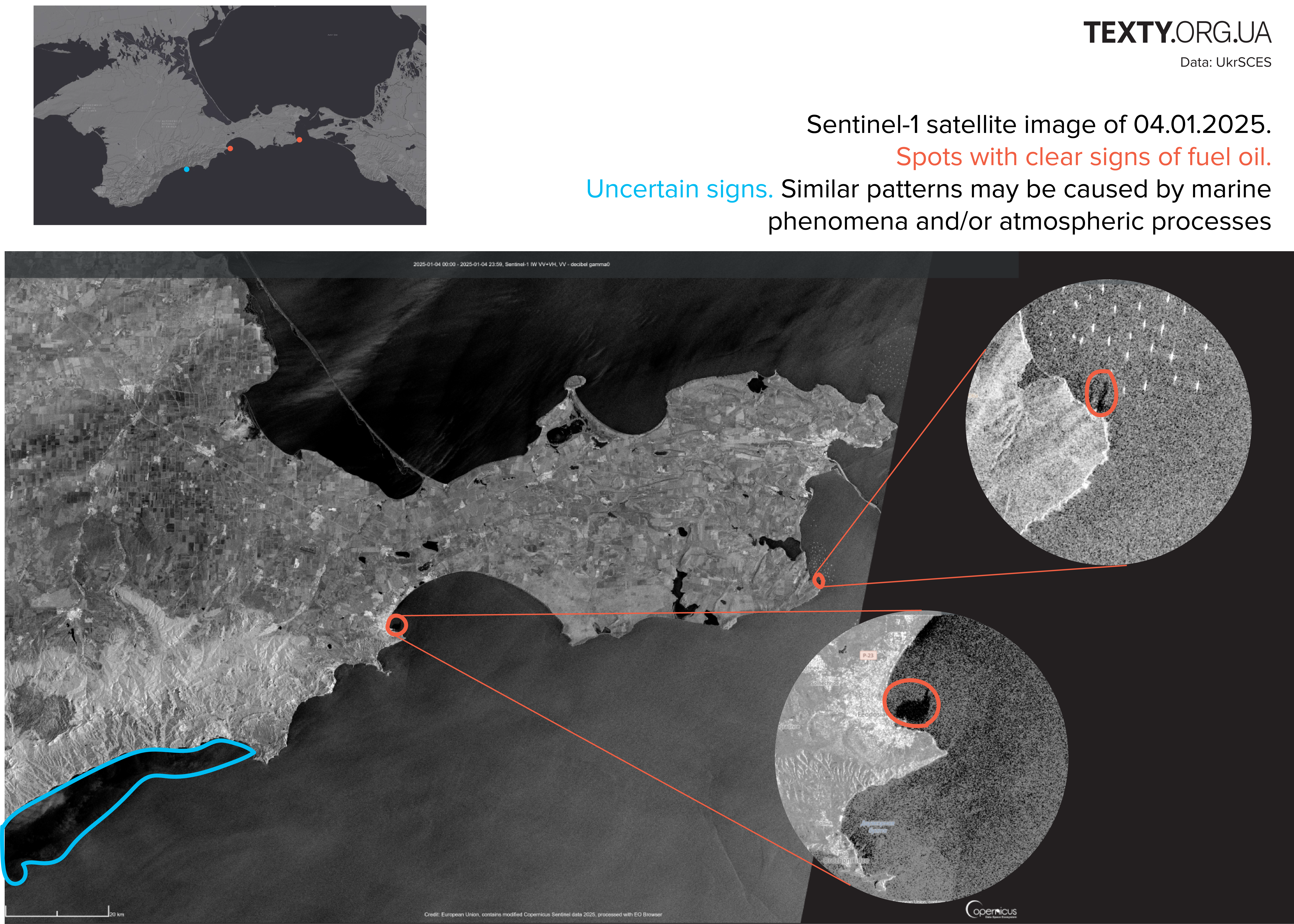
January 5
On January 5, fuel oil was spotted near Sevastopol and the village of Kacha north of Sevastopol. The total area of the contaminated water area near Sevastopol reaches 1000 km².
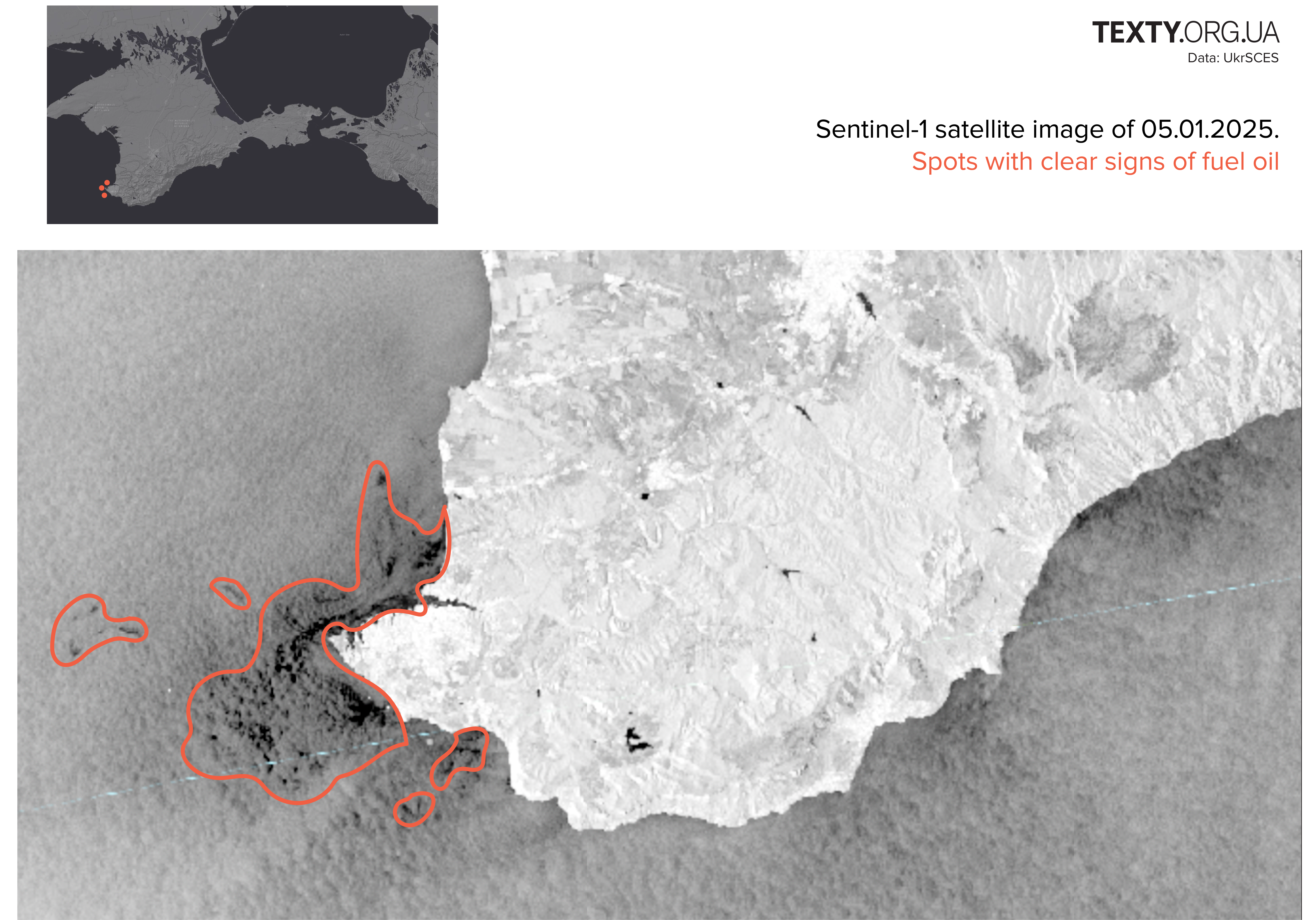
Environmental impacts
Fuel oil is a heavy residual oil product that has a toxic effect on marine life. It causes poisoning of fish and other organisms, and disrupts food chains in the marine ecosystem. It can take decades for some species to recover.
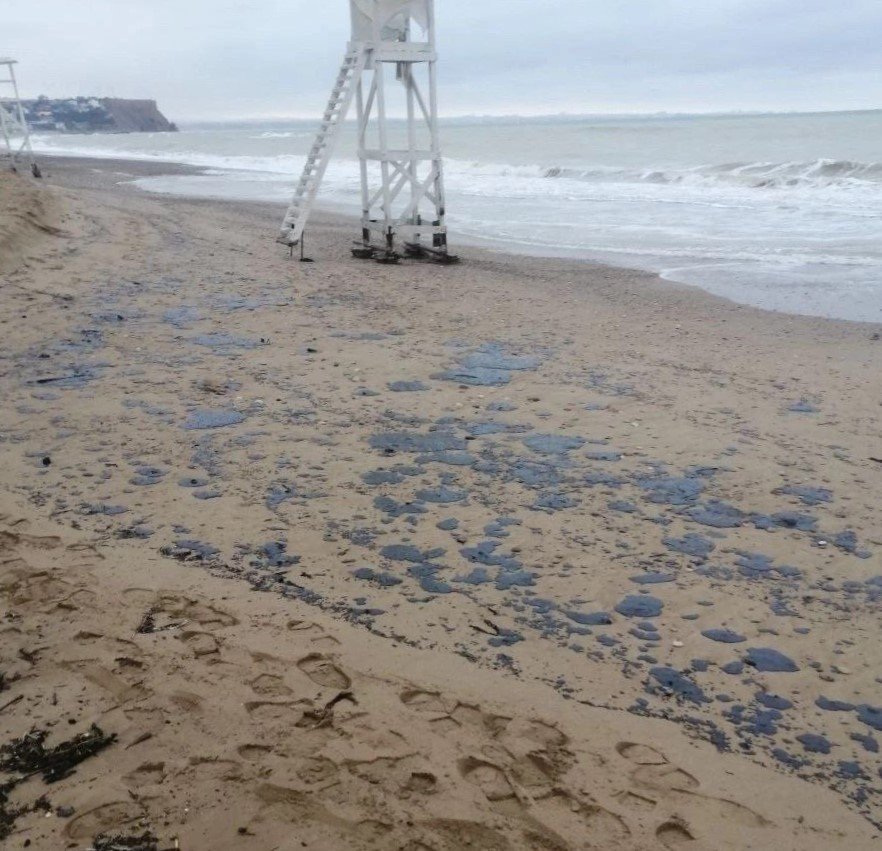
Over the past three weeks, the media have been reporting cases of animal and bird deaths and traces of fuel oil in the coastal areas of Crimea and on the Black Sea coast of Russia.
A massive stranding of dolphins in the Krasnodar region has already been reported. Environmentalists warn of the possibility of long-term pollution. There is also a risk of biodiversity decline in the region.

